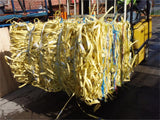Recycling Polyester Packaging
Polyester Strapping Recycling

PET or polyester is the abbreviation for Polyethylen-terephthalat, is fully recycable and may be used for manufacturing new products in many industrial sectors such as packaging films and strapping, both extruded and woven, for detergents, cosmetics, high-quality carpet fibres, foils, car parts, pillow fillings for allergic persons and fabrics. Its versatility in the many industries therefore makes it very valuable.
The Polyester Recycling Process - Where it begins.

With an abundance of bottles, and growing UK recycling capacity and potential end uses, the key to successful recycling of PET plastics lies with consumers and business users and recipients of say polyester strapping, a commonly used packaging material.throughout the world. PET containers are identified by a resin identification code imprinted on the side or bottom of the product. PET bottles for example are usually clear or transparent green, carry the resin identification code " 1 " and the symbol "PETE." They may also be recognised by the dot, or circular gate, centrally located on the bottom. Most areas of the UK now operate a weekly or fortnightly curbside collection programs that provide the consumer with bins for the collection and separation of recyclable glass, metal, and plastic containers. In some areas, drop-off bins are provided at appropriate locations in the community and at retail deposit return sites. Recycling co-ordinators ask that container caps be removed and the bottles rinsed before being placed in a collection bin. Mixed collection systems have proven to be the most efficient. In this method, the consumer simply places all recyclable containers in a common bin for pick up and delivery to a Materials Recovery Facility (MRF). The MRF subsequently separates and prepares the containers for sale to a recycling firm.
For any collection program to succeed, consumers must be disciplined so that identification and collection of recyclable containers becomes a routine activity. Most consumers readily recognise PET soft drink bottles. However, the use of PET has expanded rapidly into other areas such as containers for water, sports drinks, food products, alcoholic beverages, household products, and cosmetics.
Cleaning and Separation collected polyester
Once collected, containers are forwarded to recycling locations where they are run through grinders that reduce them to flake form. The flake then proceeds through a separation and cleaning process that removes all foreign particles such as paper, metal, and other plastic materials. Having been cleaned according to market specifications, the recovered PET is sold to plastic strapping extruders who convert it into new polyester strapping.

Recycling Capacity
There are a growing number of UK recycling companies in operation, These plants have the cleaning and separation technology to convert post-consumer bottles to flake for sale to reprocessors such as plastic strapping extruders. The recycler is the vital link between the collection process and the end users having need of the recycled resin. Industry associations also play a valuable role by bringing communities and recycling outlets together.
Use for Reclaimed PET - General
About 75%of reclaimed PET is used to make products such as fibres for carpets, fibrefill, apparel and geotextiles. Much of the remainder is extruded into sheet for thermo-forming, stretch blow-moulded into non-food containers, compounded for moulding applications. The chemical process for producing PET can be reversed by two commercially available depolymerisation methods - methanolysis and glycolosis. These processes subject clean flake to a chemical reaction that reduces it to either a monomer or the original raw materials. These materials can then be purified and subsequently re-reacted into "new" PET It has been established that the use of thermoplastic regrind at levels less than 25% by weight (0% for thermosets) does not significantly compromise the properties of the virgin material and does not require further investigation. The use of thermoplastic regrind at levels exceeding 25% by weight requires a separate investigation to verify that the material meets minimum levels of performance with regard to critical properties.
When PET is Burned for Energy Recovery much of it is sent to state-of-the-art, waste-to-energy incineration facilities, reducing the volume of waste going to landfills by as much as 90%. Incineration for energy recovery accounts for 35% of all solid waste disposal in Europe. As shown below, plastics have an inherent energy value higher than any other material commonly found in the waste stream.
When PET Containers are Landfilled
While growing volumes are being recycled and others are being incinerated, some inevitably find their way into landfills. They contain no noxious components that might leach into underground water supplies, nor do they decompose and remain unchanged for decades.Very little decomposition takes place in a modern landfill and they are in effect, solid waste repositories.
